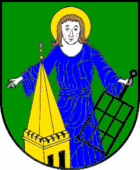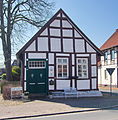Liebenau (Lower Saxony)
| coat of arms | Germany map | |
|---|---|---|

|
Coordinates: 52 ° 36 ' N , 9 ° 6' E |
|
| Basic data | ||
| State : | Lower Saxony | |
| County : | Nienburg / Weser | |
| Joint municipality : | Liebenau | |
| Height : | 26 m above sea level NHN | |
| Area : | 22.96 km 2 | |
| Residents: | 3844 (Dec. 31, 2019) | |
| Population density : | 167 inhabitants per km 2 | |
| Postal code : | 31618 | |
| Area code : | 05023 | |
| License plate : | NI | |
| Community key : | 03 2 56 019 | |
| Association administration address: | Ortstrasse 28 31618 Liebenau |
|
| Website : | ||
| Mayoress : | Margit Schmidt ( CDU ) | |
| Community and joint community of Liebenau in the Nienburg district | ||
Liebenau is a municipality and a patch in the district of Nienburg / Weser in Lower Saxony and is the administrative seat of the municipality of Liebenau .
geography
Liebenau is located about 15 km southwest of the district town of Nienburg / Weser between the Mittelweser and the eastern slope of the Nienburg-Meppener Geestplatte, which was formed during the Ice Age . The floodplain flows through the village .
history
On the Heidberg, a sand dune about 2 km southwest of Liebenau, the old Saxon cemetery of Liebenau was discovered in 1953 . The grave field was used between the 4th and 9th centuries for both cremation and body burials . During the more than 35 years of excavation by the Lower Saxony State Museum in Hanover , around 450 graves were discovered. The grave goods provided important insights into the culture of the Old Saxons and indicated that there were trade relations with distant areas. On the outskirts there was the Saxon-Carolingian settlement of Liebenau from the 8th to 9th centuries, which has been archaeologically examined since 2015.
In the written tradition Liebenau is mentioned in connection with knight and noble families in the 12th and 13th centuries. The name Liebenau appears for the first time in 1167 in a document from Henry the Lion .
Since in the 10th century St. Lawrence often appears as the patron of newly founded churches, it can be assumed that the parish of Bruchtorf with this patron saint was created at this time. It belonged to the diocese of Minden and was the place of jurisdiction for the Minden bishops . With the witness Eilward von Bructhorpe, the ancestor of the noble family " von Brockdorff ", the name of the village Bruchtorf was first mentioned in 1167.
In the Wesermarsch near Bruchtorf, the Bishop of Minden bought a castle called Venau from the Counts of Oldenburg-Wildeshausen in 1241 , which the Bishop of Minden immediately expanded in 1242 into the new moated castle Nygenhus , which was directed against the County of Hoya . In 1346 the Counts of Hoya captured the castle and destroyed it. From the stones of the destroyed castle, the Counts of Hoya built Liebenau Castle north of the Große Aue in the 14th century, around which the Liebenau area was built. The castle was destroyed by the Counts of Schaumburg around 1512. It was later only rebuilt as an official court.
The places Bruchtorf and Liebenau have been administered together since about the middle of the 14th century, although they appeared separately under their names until after the Thirty Years' War . At the beginning of the 15th century, Liebenau received stain rights. In 1709 the Liebenau office was attached to the Steyerberg office, and the Liebenauer Amtshof was demolished in 1728.
In 1939, a large ammunition factory was built in the Eickhofer Heide immediately west of Liebenau. This factory was built by Wolff & Co. in Bomlitz . It was then handed over to Montan GmbH , which leased it to Eibia GmbH , a wholly-owned subsidiary of Wolff & Co. Eibia mainly produced various powder raw materials, powders, nitrocellulose and rocket propellants on the premises for the Army High Command . From 1943, various test stands for rocket motors were also built on the site. Around 2,000 prisoners of war and forced laborers who died there were buried in the Deblinghausen war cemetery near Steyerberg.
Even after the end of the Second World War , ammunition was initially produced by Dynamit Nobel and later by the Dutch Eurometaal until 1994 on the Eibia site in Liebenau. In the early 1960s, the powder factory in Liebenau was the largest in all of West Germany.
From 1963 to 1992 the site also housed the Liebenau special ammunition depot for the 1st Panzer Division of the Bundeswehr. Today the 12 square kilometer area of the former Eibia lies largely fallow and can still not be entered without permission. Buyers and investors are wanted.
politics
Municipal council
The council from Liebenau consists of 15 councilors.
(Status: local election on September 11, 2016)
mayor
The honorary mayor Margit Schmidt was elected on November 17, 2011.
coat of arms
Blazon : “In green, the growing, gold nimbly, blue clad Saint Lawrence, who holds a black rust with his left hand; on the right in front of him the golden pointed helmet of a church tower over a battlement ”. Already in a soft-picture seal , dated 1558, shows the saint with the church. The fact that the church patron was retained even after the Reformation is explained by its importance as the patron saint of blacksmiths. Liebenau was an important place where scythes were made. The tinging of the seal picture is more recent, a picture deviating from Otto Hupp shows the saint standing and the church with its tower and nave. The main colors of the coat of arms blue and gold are based on the lion coat of arms of the dukes of Braunschweig-Lüneburg , who came into the possession of Liebenau after the Count of Hoya died out .
Culture and sights
Buildings
St. Lawrence Church
At the site of today's St. Laurentius Church there was initially a wooden church that was built around the year 900. Saint Lawrence was elected as the patron saint of this church. During the feudal wars between the Counts of Hoya and the Dukes of Braunschweig and Lüneburg, the church was partially destroyed. The inscription above the northern entrance mentions 1522 as the year of restoration. Even after the Reformation, the church patron, St. Laurentius, was retained. This is probably explained by its importance as the patron saint of the forge; the Liebenau area was well known for the manufacture of scythes.
The church is built in the late Gothic style. It is a three-aisled hall building with cross vaults. The outer walls consist of rubble stones and boulders; the sacristy is built in half-timbered style and dates from the post-Reformation period. The Protestant church is about 40 m long and 16.55 m wide. The church tower is 35 m high.
The most valuable work of art in the church is the sandstone tabernacle, also known as the tabernacle. It is a late Gothic work and is 6.5 m high. The shrine is closed with an ornate wrought iron lattice door that was made in Liebenau. The carved altar dates from 1517.
Heimathaus Witten Hus
This farmhouse, typical of the region, is located on Ortstrasse in Liebenau on a plot of around 4000 square meters. After the great fire of April 21, 1869 in Liebenau, which destroyed numerous buildings in the area of Langen Strasse and Ortstrasse, the building was rebuilt at the end of the 19th century. The house was inhabited until 1997, most recently by the Dietrich Witte family. Since no structural changes were made for many decades, the property was particularly suitable for furnishing a home. Members of the Liebenau homeland association have renovated and furnished the historic building on a voluntary basis.
The Heimathaus houses a large number of exhibits of handicraft and household items from the region. Old agricultural machinery and equipment can be seen in a barn. A functioning old threshing machine is on display in a shed.
The permanent program of the Heimatverein includes exhibitions, readings and social events. Liebenau wedding couples like to use the rustic atmosphere of the old half-timbered house for their civil wedding. In front of the building there is a memorial stone for the local historian Heinrich Gade .
Eickhof Castle
Eickhof Castle is located in the middle of the Eickhof Forest . Until 1938 the castle was the seat of the noble von Eickhof-Reitzenstein family. A Zen monastery belonging to the Rinzai line has been located in the castle since 2006 . In addition to practicing Zen, courses and seminars are offered. The castle is surrounded by a Japanese garden designed by the current owners.
Liebenau Castle
Liebenau Castle, first mentioned in 1300, was located directly on the floodplain . As a result of an inheritance dispute between the Upper County of Hoya and the Dukes of Braunschweig-Lüneburg , the castle was destroyed in 1512 and later built over. A dam led to the castle , which has been handed down to the Dammstraße in this area.
Neuhaus Castle
Neuhaus Castle , built in 1242, was located south of Liebenau near the Weser . It consisted of a castle tower and a curtain wall and was surrounded by a moat . The castle complex was built by the Minden Bishop Wilhelm to secure the area against the County of Hoya . In 1335 the Counts of Hoya managed to capture and destroy the castle. Its building remains were completely removed by 1850, presumably for building construction in Liebenau. Today the castle site is on an agricultural area.
Jewish Cemetery
The 2150 m² Jewish cemetery in Liebenau on Stolzenauer Strasse still has 70 gravestones from the period after 1850 - some of them only with Hebrew inscriptions.
Culinary specialties
- Liebenau asparagus , the special delicacy in many variations from the local growing area
Economy and Infrastructure
Liebenau is already in the past centuries by the manufacture of scythes and the clappers of peaks became known far beyond its borders.
traffic
The community of Liebenau can be reached via the L 351, which leads from Nienburg to Stolzenau . The public transport is buses as part of the public transport company Nienburg performed. The station Liebenau (Han) is located on the railway line Nienburg-Rahden , it is not there SPNV instead.
Personalities
- Georg Wagner (1844–1921), educator
- Heinrich Gade (1816–1910), educator, local researcher and honorary citizen
- Carola Ferstl (* 1968), TV presenter and book author
- Rolf Meyer (1951–2014), politician (SPD)
- Thorsten Wilhelms (* 1969), racing cyclist
- Andreas Winkelmann (* 1968), writer and thriller author
See also
- Sports club SV Aue Liebenau
literature
- Heinrich Gade: History of the patch Liebenau on the Weser. In: Journal of the historical association for Lower Saxony. Born in 1863, Hanover 1884, pp. 289–346.
- Martin Guse: Powder Factory Liebenau 1938 to 1945. Documentation Office Powder Factory Liebenau eV, Liebenau 2003, OCLC 836847227 .
Web links
Individual evidence
- ↑ State Office for Statistics Lower Saxony, LSN-Online regional database, Table 12411: Update of the population, as of December 31, 2019 ( help ).
- ^ Website on the history of the Liebenau powder factory
- ^ Website on the history of the Eibia site in Liebenau
- ↑ https://wahlen.kdo.de/content.php?kunde=sg_liebenau&wahlverz=sg_liebenau/web/201609_K__Gemeinderatswahl_Liebenau_11.09.2016&wahlname=Gemeinderatswahl_Liebenau_11.09.2016&atei=160731105481175_0_1_txt_s_.html
- ↑ Klemens Stadler: German coat of arms Federal Republic of Germany . The municipal coats of arms of the federal states of Lower Saxony and Schleswig-Holstein. tape 5 . Angelsachsen-Verlag, Bremen 1970, p. 56 .
- ^ Website of the Zen Monastery










